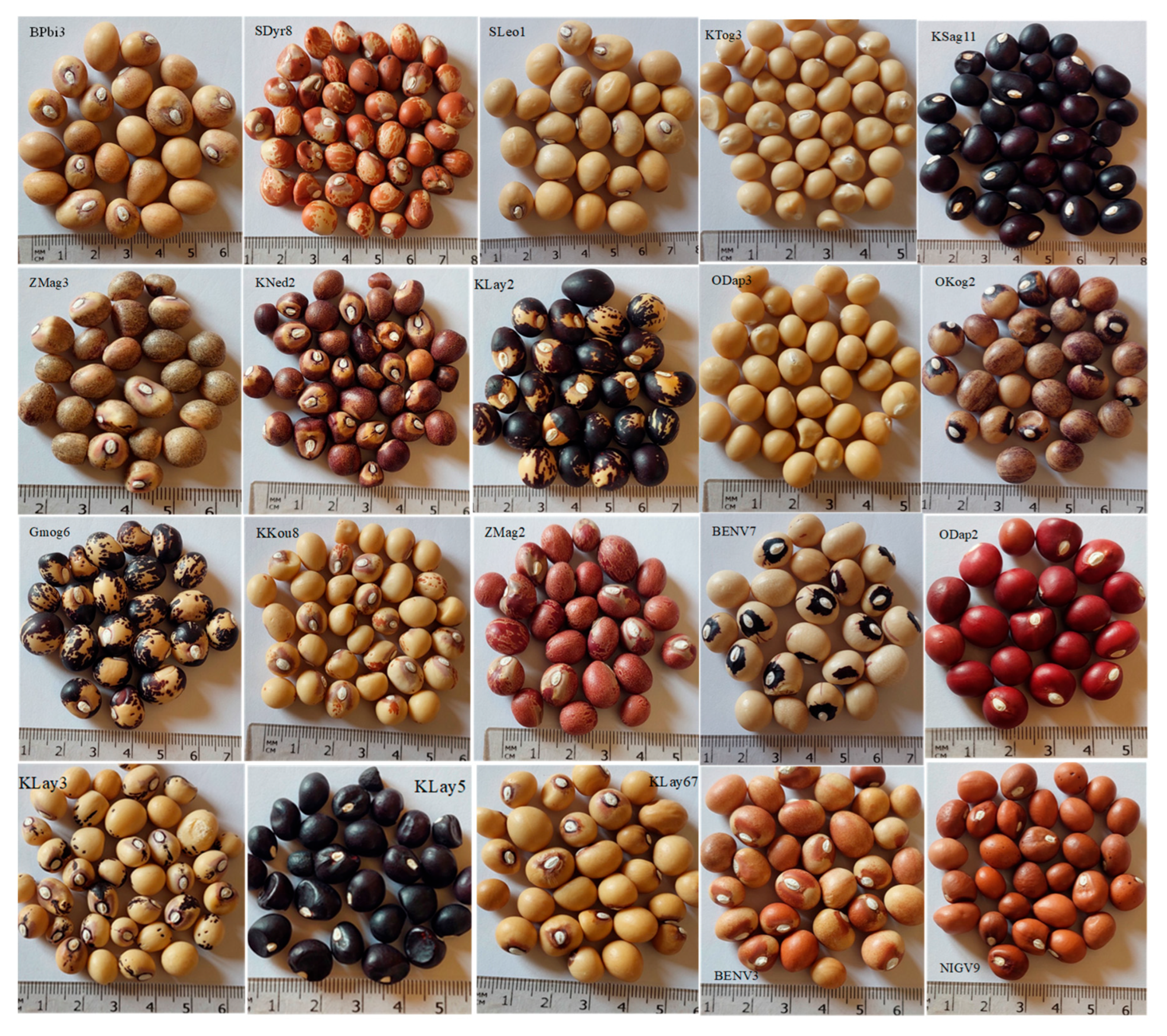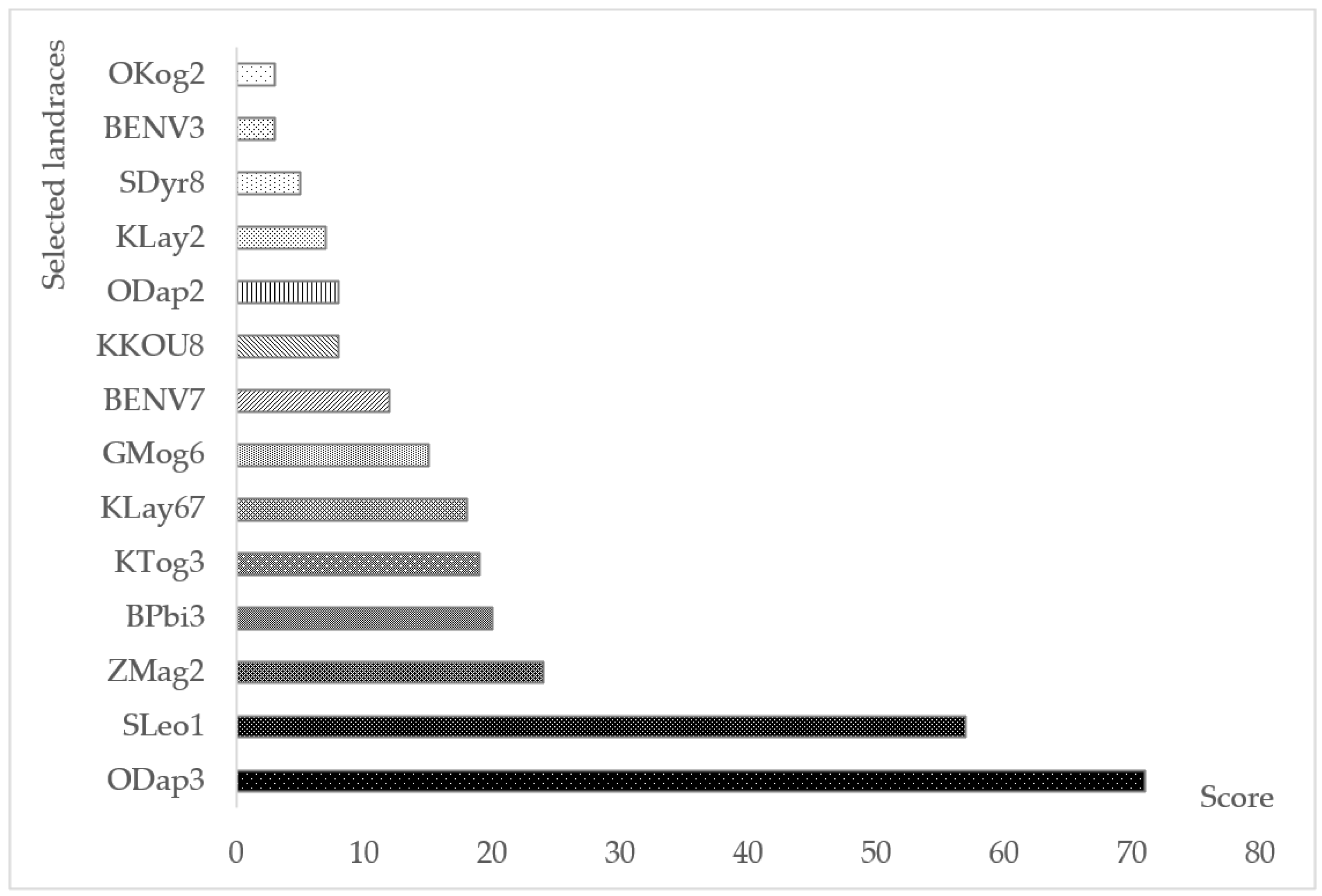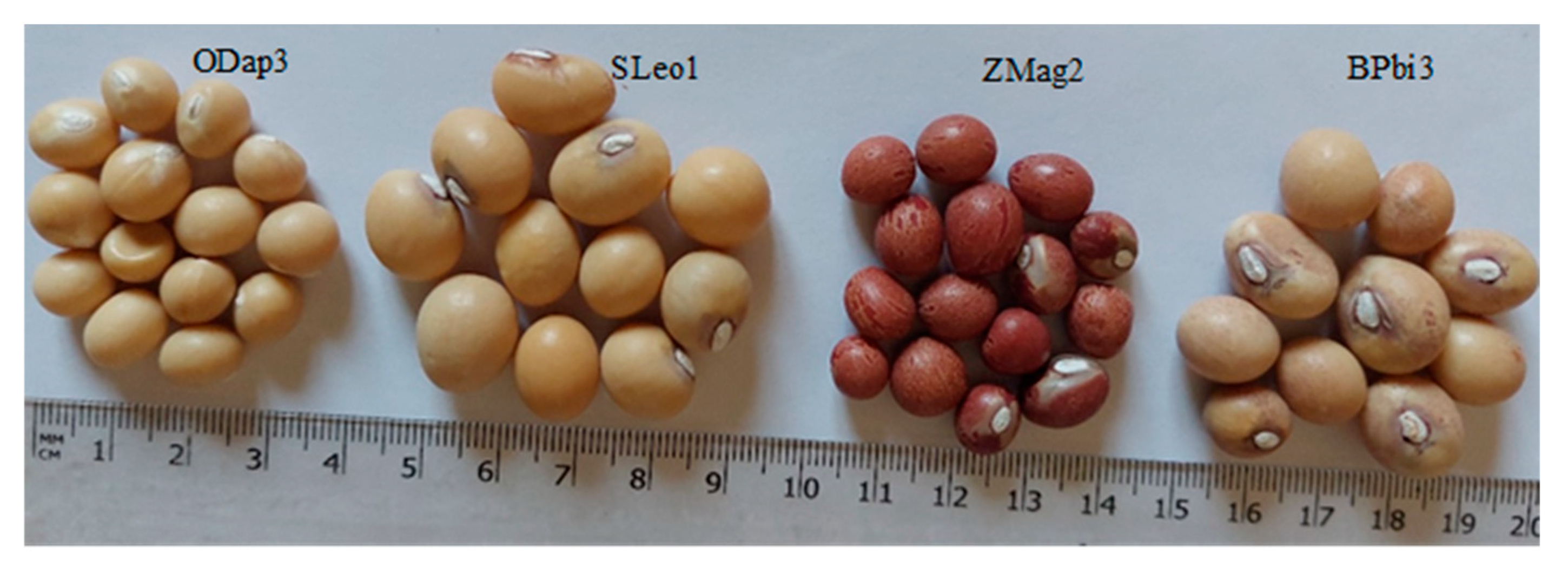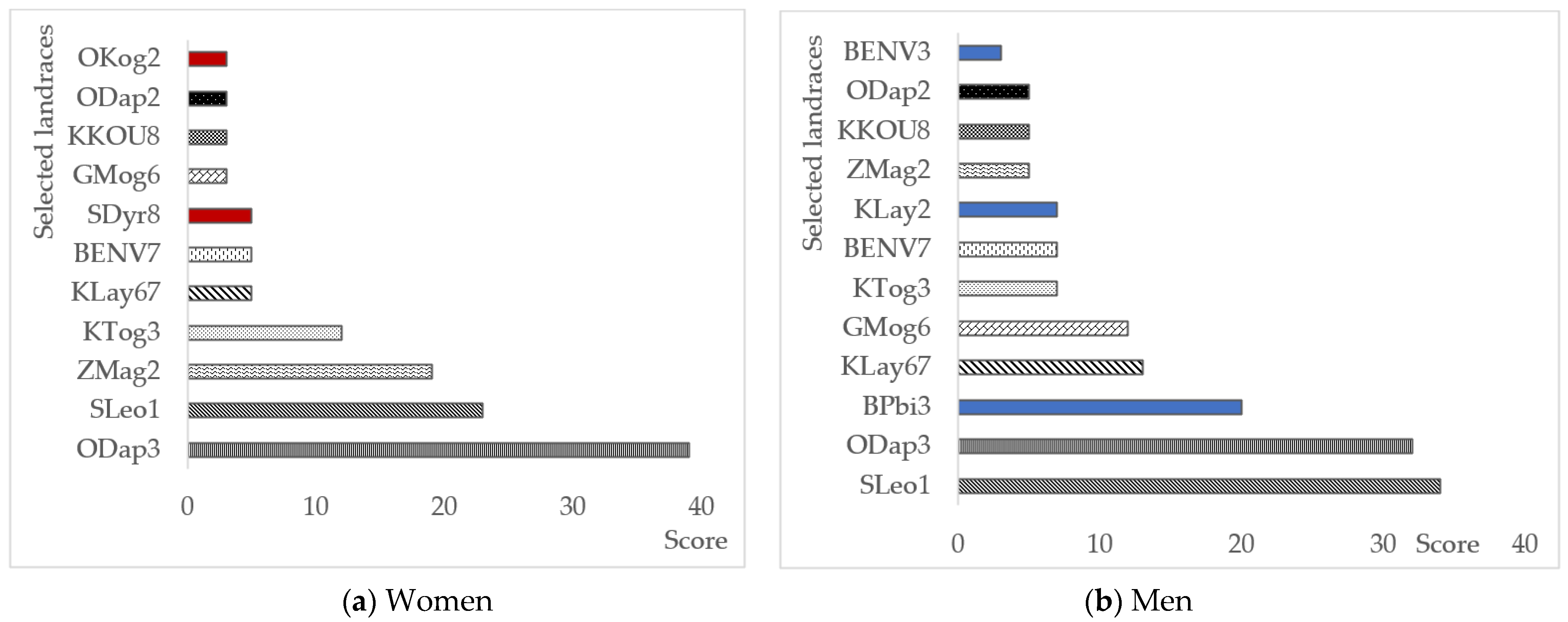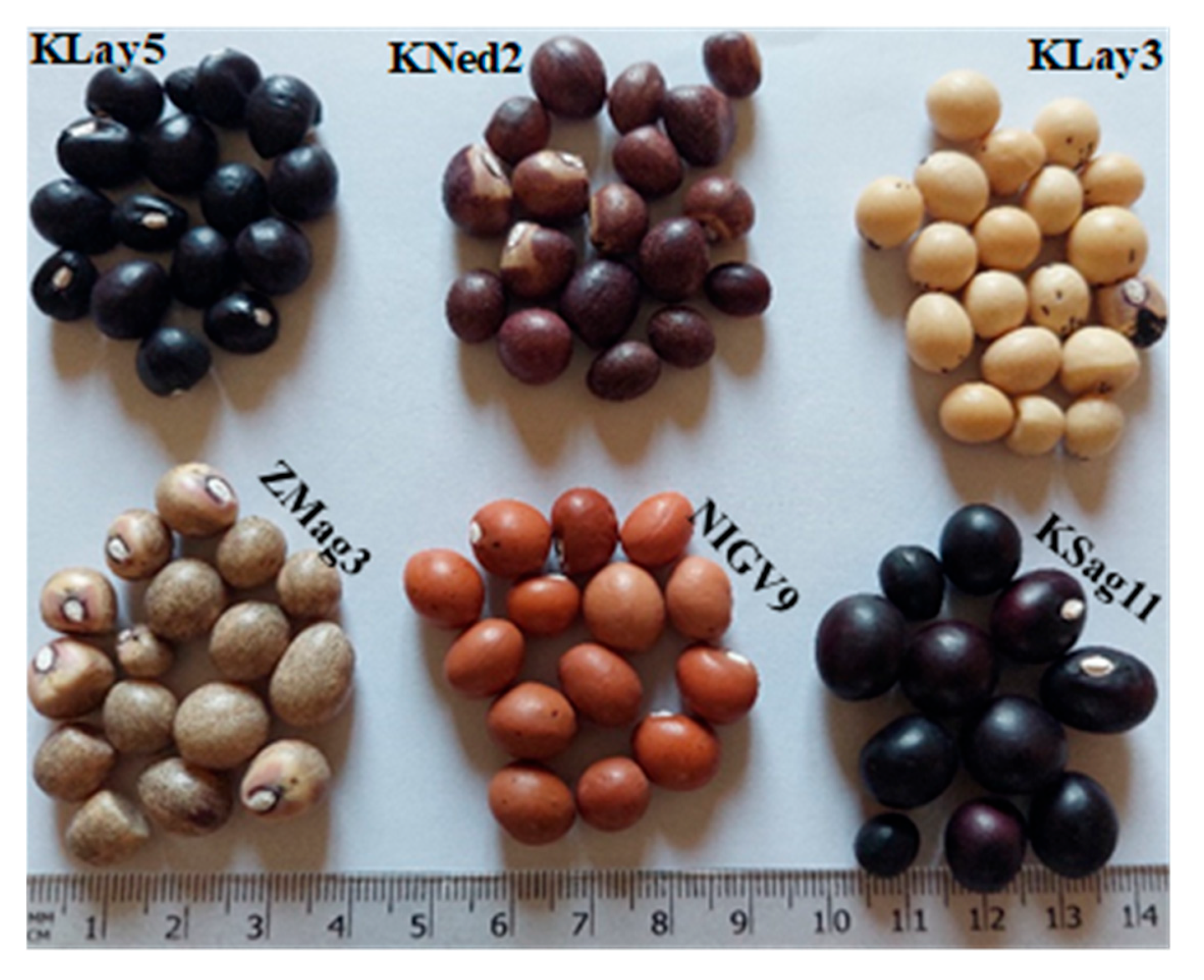1. Introduction
Bambara groundnut [BGN,
Vigna subterranea (L.) Verdc], also known as Bambara bean or Bambara nut, belongs to the family of
Fabaceae [
1,
2,
3,
4]. It is one of the oldest legume crops that originated in Africa. BGN is a neglected and underutilised species (NUS), mostly produced by females for subsistence purposes [
5], and regarded negatively as a poor’s crop, women’s crop, elders’ crop, or widows’ crop. It is mainly cultivated on a small scale in pure culture [
6] or in association with other crops [
7]. The total global BGN production was estimated at 246,511.3 tonnes in 2022 [
8]. West Africa accounts for more than half (167,031.28 tonnes) of the global BGN production [
8]. BGN production faces several constraints, such as a lack of resources, including access to quality seeds and cultivars, adapted agronomic techniques, capital and extension services, land, and storage facilities [
9]. BGN marketing is limited to local markets, and there are no data on cross-border trade [
10].
Recently, Bambara groundnut gained great attention due to its high nutritional value, tolerance to drought and poor soils, and resistance to diseases and pests [
11,
12]. As a legume, BGN can contribute to improving soil physicochemical properties by fixing atmospheric nitrogen through the nodulation process [
12]. The BGN grain is a good source of complete and balanced food. It contains up to 26–27% of protein, 55–56% of carbohydrates, 5–7% of fat, fibre, calcium, iron, and potassium [
13]. It is consumed in many ways and at different stages of maturity [
14]. BGN can be an alternative solution to animal protein deficiency in rural areas [
5]. BGN does not require major agricultural inputs and can be cultivated in rainfall-limited conditions. Therefore, BGN is a climate-smart crop for resilience under climate change. Due to its food and nutritional potentials, BGN has been recently regarded as a crop for the new millennium [
6] and a possible weapon in fighting against malnutrition in arid and sub-arid areas [
15].
Niger leads the BGN top producers (61,753.42 tonnes in 2022), followed by Burkina Faso (57,208.53 tonnes in 2022). The crop yield is very low due to a lack of quality seeds. Despite the low yields, BGN is a legume of interest to communities due to its high agri-food, nutritional, and socio-cultural value, especially in low-income rural areas where access to animal proteins is limited [
5]. The yield of BGN is generally higher in Burkina Faso compared to the other top producers. For example, in 2022, the crop yield was estimated at 1052.2 kg/ha in Burkina Faso, while only 599.8 kg/ha was reported in Niger [
8]. BGN is the third most important legume crop after cowpea (
Vigna unguiculata L.) and groundnut (
Arachis hypogaea L.) in Burkina Faso.
Despite varietal improvement efforts, the lack of varieties adapted to the needs of value chain participants remains a major challenge to BGN production. Indeed, because of the lack of available funds, BGN varietal improvement was neglected by researchers [
16]. Plant breeding has been mostly unsuccessful with BGN because of the lack of reliable scientific knowledge on its floral biology [
17]. Therefore, most of the cultivated Bambara groundnut genotypes are local landraces [
16]. A large number of BGN landraces were observed throughout Africa, especially in West Africa. To date, the genetic diversity of the crop remains largely unexploited [
16].
Due to the unavailability of improved varieties, farmers cultivate the existing local landraces. Traditional landraces have the disadvantage of having low yields and undesirable varietal characteristics, and do not always meet the needs of value chain participants. However, they have the advantage of being phenotypically and genotypically more diverse and adapted to various local farming conditions than improved varieties. Landraces are “varieties with a high capacity to tolerate biotic and abiotic stress, resulting in high yield stability and an intermediate yield level under a low input agricultural system” [
18]. Therefore, they constitute a strategic source of genes of interest and offer the possibility of selecting varieties adapted to local environmental conditions and to the needs of value chain participants.
Understanding the relevant varietal selection criteria and identifying a set of landraces according to the BGN value chain participants’ preferences would be a significant step towards varietal improvement and can contribute to the development of the BGN sector in Burkina Faso, Niger, and other sub-Saharan countries. This requires a participatory approach in defining selection criteria and selecting landraces according to the needs of BGN value chain participants. Participatory varietal selection may increase breeding efficiency and the rate of adoption of new cultivars by growers and, thereby, make it possible to overcome the constraints faced by the value chain participants [
19]. Indeed, differing expertise in varietal selection was often observed across the diversity of participants. For example, some women are known for their ability to finely distinguish varieties suited to particular agricultural contexts [
20].
Through a participatory approach, the present study aims at (i) describing the agro-morphological characteristics of a selected core collection of BGN, (ii) identifying relevant selection criteria according to BGN value chain participants’ preferences, and (iii) identifying a set of landraces according to BGN value chain participants’ preferences in Burkina Faso.
3. Results
3.1. Characteristics of the Selected Core Collection Used for the Participatory Selection
Based on agro-morphological diversity, a
core collection of landraces was generated from the larger collection consisting of 200 cultivars. The selected
core collection included 20 landraces from Burkina Faso (17 landraces), Benin (2 landraces), and Niger (1 landrace). In Burkina Faso, the 17 landraces were collected from 12 villages located in nine provinces (
Table 1). The collection sites in Benin and Niger were not identified.
3.2. Description of the Selected Core Collection Using Qualitative Traits
The
core collection represents the maximum phenotypic diversity of 200 varieties characterised. The six qualitative traits recorded on the
core collection showed variation for all traits (
Table 2). A great diversity was observed for all the qualitative traits. Out of all the traits, seed colour was the most variable, while the seed shape was the least variable. Several modalities were observed for seed colour and eye colour, two modalities for seed shape, and three modalities for seed size.
The majority of the landraces produced oval seeds (90%), while only 10% of them produced round seeds. Referring to seed colour, most of the landraces (60%) exhibited composite seed colour (
Figure 2). Forty per cent (40%) of them showed uniform seed colour, such as cream (20%), black (10%), and red (10% of light or dark-red).
According to the presence or absence of an eye around the seed hilum, up to 70% of landraces produced seeds with eyes such as grey eye (45%), black eye (15%), and brown eye (10%). Only 30% of landraces produced no-eye seeds. In relation to eye shape, two types were revealed, namely triangular and butterfly-shaped. Only the landrace Sleo1 produced seeds with a hilum surrounded by triangular eyes. The other landraces showed a hilum surrounded by butterfly-shaped eyes. Related to seed size, landraces produced seeds with large size (35%), medium size (20%), and small size (45%).
3.3. Description of the Core Collection Using Quantitative Traits
The study revealed a large variation in the BGN landraces quantitative traits. The analysis of variance showed significant variation between the landraces for all the traits except plant spread (
Table 3). The number of days to 50% flowering ranged from 33 to 38 days, with an average of 36 days, while the number of days to 95% maturity ranged from 90 to 101 days, with an average of 95 days. The coefficients of variation were low for the number of days to 50% flowering (4.58%) and the 95% maturity (3.68%).
The earliest flowering landraces were SLeo1, ODap2 and OKog2, while the latest flowering ones were KNed2, GMog6, and KKou8. In relation to maturing time, the earliest landraces were BENV3, ODap3, KLay53, KLay3, KTog3, and KLay2, while the latest maturing ones were ODap2, KSag11, KKou8, ZMag2, SLeo1, KLay67, and GMog6. It is worth noting that the landraces ODap2 and SLeo1 start flowering earlier than the other landraces but ripen later than the others due to their long cycle. The landraces ODap3, BENV3, and KLay2 start flowering and mature earlier than the other landraces due to their short cycle.
Average plant height varied from 16.64 (NIGV9) to 24.83 cm (BPbi3) with an overall average of 19.82 cm and a coefficient of variation of 16.29%. The average pod number per plant was very variable, ranging from 7 to 34 pods per plant, with an overall average of 21 pods and a larger coefficient of variation of 64.74%. In terms of average number of pods produced per plant, the landraces KTog3, SLeo1, ODap2, and ODap3 were the most productive (with 34, 30, 27, and 26 pods, respectively) while KKou8, BENV7, and BENV3 were the least productive (with 7, 11, and 13 pods, respectively).
The yield was very variable, varying from 0.26 to 1.56 tonnes per hectare. The mean yield was 1.01529 tonnes with a larger CV of 61.06%. The highest-yielding landraces were BPbi3, KTog3, ODap2, ODap3, OKog2, and SLeo1 (up to 1.23–1.56 t/ha), while the lowest yields were recorded for KKou8, BENV3, BENV7, ZMag3, and ZMag2 (0.26–0.80 t/ha). The average seed length varied from 7.92 to 12.67 mm with an overall average of 11.06 mm, while the average seed width ranged from 6.02 to 10.40 mm, with an overall average of 9.22 mm. The coefficients of variation observed for these two variables were 9.20% and 8.60%, respectively. The largest seed sizes were recorded for landraces BPbi3, SLeo1, and KLay2, while the smallest ones were observed for landraces KKou8 and KTog3.
3.4. Relationship Between Quantitative Traits
Overall, five positive correlations between traits were observed (
Table 4). Positive and strong correlations were observed between plant height and plant spread (r = 0.611), pod number per plant and crop yield (r = 0.796), and seed length and seed width (r = 0.948). Two positive and moderate correlations were revealed between seed length and yield (r = 0.489) and seed width and yield (r = 0.591).
3.5. Participatory Varietal Selection
3.5.1. Demographic Characteristics of Participants
Participants were fairly gender-balanced (55% male and 45% female) and mostly young, with an average age of 37 years. The youngest participant was 24 years old, while the oldest was 78 years old. Seven different ethnical groups were identified. The majority of participants (44.46%) were Moossé, followed by Bissa, Bwaba, Dafing, and Samo (11.10%, respectively). Fulani (Peuls) and Goin were the least represented (5.57%, respectively). With regards to the different groups of value chain participants, breeders and consumers were the most numerous (27.77%, respectively). They were followed by producers and processors (16.67%, respectively), while agricultural extension agents were the least numerous (11.12%).
3.5.2. Key Selection Criteria
Ten selection criteria of interest—including seed colour, seed size, cultural value, market value, seed taste, seed cooking duration, easy storage, crop yield, seed appearance (smooth seed), and nutritional value—were recorded across the value chain participants (
Figure 3). The most important criteria identified were seed colour, seed size, cultural value, and market value. In reference to colour, the cream-coloured seeds were more preferred (89.36% of participants) than the other seed colours (10.64% of participants). In relation to seed size, large seeds were more preferred (76.56% of participants) than medium (15.63% of participants) and small ones (7.81% of participants). All the participants preferred short cooking duration and high yield over alternative trait values.
According to
gender, nine relevant selection criteria were recorded for men and seven criteria for women (
Figure 4). Six of the criteria (seed colour, seed size, cultural value, market value, taste and cooking duration) were common to both men and women. Some differing criteria according to
gender were exhibited. Indeed, nutritional value is a criterion of interest for women only, while seed appearance (smooth seed), crop yield and easy storage are criteria of interest for men only. For both men and women, seed colour, seed size and cultural value are the most important criteria. Referring to colour, the cream-coloured seeds were more preferred by both men (91.94% of participants) and women (87.18%) than the other colours. In reference to seed size, the large seeds were more preferred by both men and women (100% and 53.13%, respectively) than medium (31.25% for women) and small ones 15.62% for women). The chi-square test across gender indicated significant differences between women’s and men’s selection criteria (
Table 5).
Regarding criteria of interest across different groups of
value chain participants, seven criteria were listed as relevant criteria for producers and breeders, six key criteria for processors and consumers and four criteria for agricultural extension agents (
Figure 5). Three criteria (seed colour, seed size, cultural value) were common to all the
value chain participants. However, some differing criteria were also highlighted, depending on the different groups of
value chain participants. The importance of the criteria varied according to the
participants. For example, criteria such as seed taste, market value and seed cooking duration are of interest to breeders and consumers, while crop yield and easy storage of seeds are criteria of interest to producers only. In relation to colour, the cream-coloured seeds were preferred by all the participants. Indeed, 84.38% of consumers, 100% of producers, 100% of breeders, 66.67% of processors and 100% of agricultural extension agents preferred the cream-coloured seeds, while 15.62% of consumers and 33.33% of processors preferred the other colours. As for seed size, the large seeds were preferred by all the participants over medium and small ones. One hundred per cent (100%) of producers, processors and consumers, 58.34% of breeders and 50% of agricultural extension agents preferred large seeds. Only 20.83% of breeders preferred medium and small sizes, respectively, while 50% of agricultural extension agents preferred medium size. The chi-square test, according to value chain participants, showed significant differences between participants’ selection criteria of interest (
Table 6).
3.5.3. Landraces of Interest for the Value Chain Participants
Out of the 20 landraces used for the participatory varietal selection, the BGN
value chain participants selected a total of 14 landraces (
Figure 6), of which ODap3 (total score: 71) and SLeo1 (total score: 57) were the most preferred (
Table 7). These two landraces share common features such as oval seed shape and cream-coloured seeds. However, there are some differences between them. For example, SLeo1 is characterised by a large seed size and the presence of a grey triangle-shaped eye around the hilum, while ODap3 is characterised by a small seed size without an eye around the hilum. The four most preferred landraces are shown in
Figure 7.
With regards to
gender preferences among selected
core landraces, both men and women preferred ODap3 and SLeo1 (
Figure 8). However, the priority in choice varied according to men and women. Indeed, ODap3 is the women’s most preferred landrace while SLeo1 is the men’s most preferred landrace. In addition, there are some specific choices according to
gender. BPbi3, KLay2, and BENV3 were selected by men only, while SDyr8 and OKog2 were selected by women only. In this respect, the chi-square test indicated significant differences in men’s and women’s preferences (
Table 7).
With regard to the different groups of value chain participants, the number of selected landraces varied notably from four to ten. Seven landraces were selected by producers and breeders, four by processors, and six by agricultural extension agents. Up to ten landraces were selected by consumers (
Table 8). Concordances in the preferences of the participants for certain landraces were observed. For example, ODap3 was the most preferred landrace for all the participants except for agricultural extension agents, while SLeo1 was the second most preferred for them, except for producers.
Discordant preferences were also highlighted between the different groups of value chain participants. ZMag2 was selected by consumers, breeders and agricultural extension agents only, while KTog3 was preferred by consumers and breeders only. The results from the chi-square test performed across the preferences of value chain participants highlighted significant differences (
Table 8).
Out of 20 landraces, six were not selected (
Figure 9): KLay3, KLay5, KNed2, KSag11, NIGV9 and ZMag3. These are black, red, or cream-coloured seeds with black spots.
The FGDs indicated that black and red-coloured seeds are less preferred than others due to their supposedly very long cooking time and their unattractive appearance after cooking. However, some believe that seeds of these cultivars are more nutritious than others in the selected core collection. According to FGDs, black-coloured seeds are said to be particularly sought after by certain consumers for specific uses.
Socio-cultural factors influencing and maintaining BGN diversity were identified by participants. For instance, landraces with light-brown tripes on dark-red background (for instance, ZMag2) are associated with several cultural practices in western Burkina Faso. However, many negative taboos and beliefs that hamper the development of the BGN value chain are also identified by participants. For example, in some regions of Burkina Faso, only widows or post-menopausal women are allowed to cultivate BGN. The landrace with cream-coloured seed (KTog3) is the most common BGN in Burkina Faso. It is the most produced, consumed, and commercialised landrace in local markets.
4. Discussion
The soil characteristics and the rainfall recorded during the experiment were in accordance with the soil and the requirements for BGN production [
25]. The highly significant variation in phenotypic traits suggests that the
core BGN collection used for the study is suitable for participatory varietal selection. This high diversity offered the BGN value chain participants the possibility of selecting landraces according to their needs. The high diversity highlighted is not surprising since the sample used is a selected
core collection generated from 200 landraces collected in three countries in West Africa (viz., Burkina Faso, Benin, and Niger), the centre of origin of BGN. Additionally, landraces are generally more diverse than improved ones. BGN landraces are particularly known for the great variability in phenotypic traits [
26].
The plant cycles are in accordance with some previous studies carried out in Niger [
27] and Burkina Faso [
28]. However, the landraces are earlier than those used in other studies carried out in Malaysia [
29] and South Africa [
30]. This suggests interestingly that the landraces used in the present study have a good potential to be more resilient to climate change, which is leading progressively to a shortening of rainy seasons in West Africa. The landraces, such as SLeo1 and Odap2, which have a long maturing time, have advantages and disadvantages. With regard to production, a long maturing time leads to good seed-filling rates, resulting in good yields. The disadvantages include the inability to complete their cycle in case of drought, generally observed at the end of rainy seasons.
Generally, the earlier landraces, like BENV3 and KLay2, have relatively low-yielding potential but are suitable for arid zones where rainy seasons are short. Interestingly, Odap3 is one of the earliest landraces and also one of the most productive ones. It is worth noting that the yields of certain landraces recorded in this study are higher than those reported in Burkina Faso, Niger, and Cameroon, the top producers of BGN in Africa [
8]. This is a great opportunity for breeders to select varieties with high-yielding potential.
Out of the correlations identified, the one between pods number per plant and crop yield was, by far, the most important, suggesting that the pods number per plant is a more interesting variable than the seeds number per pod. The positive correlation between seed size and yield indicates that larger BGN seeds lead to higher crop yields.
The participatory varietal selection, involving gender-balanced participants from different age groups and different groups of BGN value chain participants, was very interesting. Indeed, this made it possible to assess the variation in preferences based on socio-professional specificities. Many authors underlined the differing expertise in participatory varietal selection [
20,
31]. The significant differences according to
gender and
value chain participants’ selection criteria of interest revealed by chi-square tests support such claims.
The number of participants across the ethnic groups and the different groups of BGN value chain
participants is fairly balanced. It is not surprising that participants from the
mossé ethnic group were predominantly represented since the
mossé ethnic group is the majority in the study area. The number of selection criteria varied greatly according to
gender and the different groups of BGN
value chain participants. Some selection criteria overlapped, while others were specific to certain groups of
participants. However, seed colour (cream) was, by far, the most important criterion for all the
participants. Surprisingly, the cultural value of landraces was identified as a very important criterion that guided the participants’ choice. This demonstrates that cultural practices could contribute to maintaining the genetic diversity of neglected and underutilised species such as BGN. Similar results have revealed the socio-cultural role in influencing and maintaining crop diversity [
32].
The nutritional value, exhibited only by women as a relevant criterion, suggests that women are more aware of the BGN nutritional potential than men. Indeed, in Burkina Faso, some women use BGN seed flour for food supplementation, especially for infants. As a result, this underscores the important role of BGN in fighting against food insecurity and multi-deficiency malnutrition, on the one hand, and the leading role of women in promoting NUS, on the other hand.
Reducing BGN cooking duration is a major challenge that research has to address. The long cooking time is an obstacle to the widespread adoption of BGN [
33,
34]. In a global warming context requiring the reduction in firewood, charcoal, and gas use, the long cooking time of BGN is a disadvantage that is counterbalanced by the desirable capacity to restore degraded soils by fixing atmospheric nitrogen [
12]. Also, a long cooking time with open fire or traditional cookstoves may contribute to respiratory and other diseases [
35], especially of women, who usually perform this task.
Surprisingly, participants do not seem to give much importance to yield, although this is reported by several authors to be a major constraint to BGN production [
29,
36]. This could be explained by the fact that the BGN yield observed in Burkina Faso is higher than that reported in several West African countries [
8]. This is in concordance with the high-yielding potential of some landraces identified in this study. Indeed, out of the top eight producers of BGN in Africa (viz. Niger, Burkina Faso, Cameroon, Mali, Togo, Zimbabwe, Democratic Republic of the Congo and Zambia), the highest yield was observed in Burkina Faso (1052.2 kg/ha) followed by Zambia (912.5 kg/ha), Cameroon (828.7 kg/ha), and Togo (822.6 kg/ha) in 2022 [
8,
37]. Although Niger is the leading BGN-producing country, the yield of BGN in Niger (599.8 kg/ha) is very low [
8]. The low-yielding potential of varieties, generally mentioned as the major obstacle to the development of BGN cultivation in Burkina Faso, seems to be of second rank compared to negative perceptions, beliefs and taboos reported by participants. Investigations should be carried out in Burkina Faso to assess the link between these negative perceptions and the NUS value chain’s development.
It is worth noting that disease-resistance and drought-tolerance were not listed as relevant selection criteria for participants. This could be justified by the fact that BGN is generally considered to be more resistant to diseases and pests and more tolerant to drought and poor soils than the other legumes cultivated in Burkina Faso [
11,
12].
The selected landraces are in line with the inventoried key selection criteria. Out of the top three selected landraces, 3/3 of those selected by men and 2/3 of those selected by women were cream-coloured seeds, confirming that colour is, by far, the most important criterion. The presence of landrace ZMag2 (light-brown tripes on dark-red background) in the top three selected by women should be explained by the economic role and cultural practices associated with this landrace. For example, in western Burkina Faso, it is prepared and marketed by women as a snack, such as popcorn.
The top three landraces selected (SLeo1, ODap3, and BPbi3 for men, ODap3, SLeo1, and ZMag2 for women) by BGN value chain participants have very interesting characteristics, but also disadvantages. Referring to advantages, ODap3, SLeo1, and BPbi3 are landraces with high yield potential, up to 1.56 t/ha. Therefore, they can be used by breeders for the development of high-yielding varieties. ODap3 is a very early landrace; therefore, it is suitable for the Sahelian region, where rainy seasons are short. It can be used by breeders for the development of extra early varieties for Sahelian regions. In relation to disadvantages, SLeo1 has a long cycle. ZMag2, in addition to having a long cycle, also has a low yield. Landraces BPbi3 and SLeo1 have large seeds, unfortunately resulting in a longer cooking time. The landraces from Benin and Niger were less competitive compared to those from Burkina Faso, both in terms of agronomic performances and participants’ preferences. Their low agronomic performances could be explained by the fact that these exotic landraces were unable to fully express their genetic potential in a new environment.
Most of the unselected landraces are dark-coloured, rejected because of their supposedly longer cooking time, contrasting with the results from focus group discussions that indicate that the dark-coloured seeds would be potentially more nutritious than others. This is a major drawback because previous studies showed that landraces with dark-coloured seeds have the highest protein and anthocyanin contents, which are very beneficial for the human diet [
38,
39]. Therefore, it would be interesting to carry out investigations to establish the link between BGN landrace seed colour and their cooking duration.

